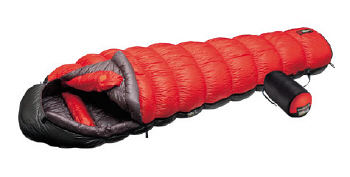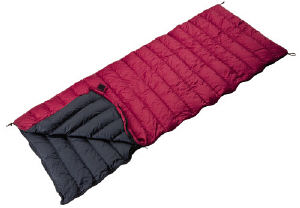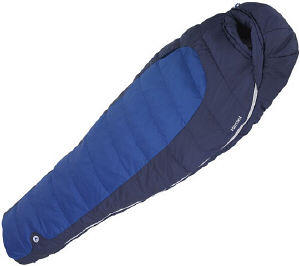Sleeping Bags for Travelers: Bagging Your Journey
by David Stephens
 The trip’s organised, and you’re starting to collect everything you need for the adventure of a lifetime: backpack, clothes, travel book, passport. But what about a sleeping bag? Is it a good idea? Read on as we divulge some hints and tips about sleeping bags for the traveller.
The trip’s organised, and you’re starting to collect everything you need for the adventure of a lifetime: backpack, clothes, travel book, passport. But what about a sleeping bag? Is it a good idea? Read on as we divulge some hints and tips about sleeping bags for the traveller.
To bag or not to bag?
No one enjoys lugging around a heavy pack, so perhaps the most important question you have to ask yourself is ‘do I need a sleeping bag?’ And it depends on what you’re going to do. Hotels, hostels, train sleeping compartments, and ferry sleeping berths usually (but not always) come with bedding; so a sleeping bag certainly isn’t necessary for survival. But can you see yourself in one of these situations?
- Making yourself comfortable in ‘deck class’ (ie. outside on the deck) on ferries sailing around the Greek Islands
- Doing that once-in-a-lifetime trek through hill tribes in the mountains of Vietnam
- Hearing the high pitched hum from the mosquitos infesting that cheap hotel room in Indonesia
- Staying at your friend’s apartment in Paris where they have space on the floor for you, but not much else.
- Waiting in the freezing cold train station at 3 a.m.
- Booked into that cheap hostel that gives you one blanket, when you really need four
- In need of a ball for that impromptu game of rugby
If any of those situations sound familiar (or you want them to), then a sleeping bag may be a go. However, taking a sleeping bag doesn’t necessarily mean lots of excess weight and bulk.
What bag to bag?
 When most people think of sleeping bags, they picture those used by mountaineers climbing K2 in Pakistan, or the sleeping bag you used to use as a kid when ‘camping’ in your backyard. But there are other bags that are perhaps better for your travels. Let’s have a look at some of the things you want to think about:
When most people think of sleeping bags, they picture those used by mountaineers climbing K2 in Pakistan, or the sleeping bag you used to use as a kid when ‘camping’ in your backyard. But there are other bags that are perhaps better for your travels. Let’s have a look at some of the things you want to think about:
- Materials – The bags you’re interested in will be made of synthetic materials. The bags mountaineers use are filled with down, and down is hard to beat. But the synthetic materials are cheaper, more durable, no heavier, and often can even be washed – much better for travelling.
- Temperature rating – All sleeping bags are given a temperature rating – a guide to the range of temperatures that the bag will be comfortable in. Unless you plan to go camping and are packing a tent, you’ll be using your travelling sleeping bag indoors. So consider a bag with a higher temperature rating (say +5°C, or +35°F). Of course, if you’re travelling around Norway in winter, you might want a warmer bag.
- Weight and bulk – You don’t want your sleeping bag taking up half you pack and weighing heaps, so this is one of the most important things to consider. A good bag doesn’t have to weigh much more than 1kg, and should almost fit into your hand – have a look at the Snugpak Softie series for some great examples of travel sleeping bags.
- The bag outside the bag – I still remember the old days where you’d spend hours trying to get your sleeping bag back in the carry bag it came from. Today, manufacturers have woken up, and this shouldn’t be a worry. However, try to get a compression carry bag with your sleeping bag – these have straps that you can use to compress the packed sleeping bag down, which saves space.
Sleeping sheets
 Sleeping sheets, sometimes also called sleep sacks, are thin sheets that are designed to fit inside a sleeping bag or used on their own. Although not essential, they can be a great idea. Why?
Sleeping sheets, sometimes also called sleep sacks, are thin sheets that are designed to fit inside a sleeping bag or used on their own. Although not essential, they can be a great idea. Why?
- Sheets keep your sleeping bag clean – and it’s much easier to wash a sleeping sheet than a sleeping bag – particularly on the road!
- Sheets protect your sleeping bag, so it’ll last you longer (and sheets are cheaper than sleeping bags).
- In conditions too hot for the sleeping bag – you can just use the sleeping sheet. Great for hostels that provide blankets but no sheets, or for hiding from those mosquitos buzzing around at night.
- Sleep sacks are also great to use independently of a sleeping bag if you’re at all questioning the cleanliness of those hostel beds.
- They add just a bit more warmth on those really cold nights.
So what to look for in a sleeping sheet?
- Materials – most sheets are cotton or silk – stay away from synthetic fabrics. Cotton sheets are good, but have a think about silk ones. If you don’t mind the feeling of silk as you sleep (and I love it!), these are lighter, less bulky, and dry quicker – though more expensive to buy.
- Style – there are 2 main styles – the basic bag, and the ‘hostel’ style that has a pillow-case attached. You can either put the pillow that’s provided into this case, or stuff it with your own clothing if there’s no pillow around.
- Always hop into the sleeping bag to check you fit before you buy it – particularly if you’re a bigger person!
- When buying a sleeping bag, take the sleeping bag out of the carry bag, and put it back in. Ask the shop for the best way to pack it.
- Have a look at backpackgeartest.org for independent test reviews of all sorts of backpacking gear.
- When travelling, remember that your carry bag generally isn’t waterproof. So when packing your sleeping bag, place a plastic bag inside the carry bag first, then pack your sleeping back inside the plastic bag. So even if your backpack goes swimming, you’ll be warm and dry that night!
A test case – What’s my bag?
I always take a light sleeping bag wherever I go – at the moment I use a Vango Ultralite 700 with a silk inner-sheet. It weighs about 1kg, keeps me warm down to about +5°C (though it gets less warm as it gets older), and packs to a nice small space. It’s saved me in some of the most unlikely places, including the mountains of Papua New Guinea and camping in the Sahara Desert in Tunisia mid-summer (cold at night).
